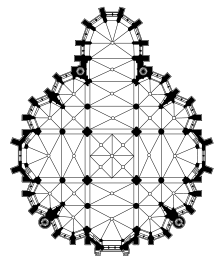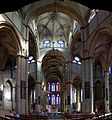Liebfrauenkirche, Trier
| Liebfrauenkirche Church of Our Lady | |
|---|---|
 | |
| Basic information | |
| Location | Trier |
| Geographic coordinates | 49°45′21″N 6°38′35″E / 49.755885°N 6.64315°ECoordinates: 49°45′21″N 6°38′35″E / 49.755885°N 6.64315°E |
| Affiliation | Roman Catholic |
| Region | Trier, Germany |
| Ecclesiastical or organizational status | Minor Basilica |
| Leadership | Roman Catholic Diocese of Trier |
| Website | http://www.liebfrauen-trier.de/index.htm |
| Architectural description | |
| Architectural type | Church |
| Architectural style | Gothic |
| Groundbreaking | ~1230 CE |
| Completed | 1260 CE |
The Liebfrauenkirche (German for Church of Our Lady) in Trier, is, along with the Cathedral of Magdeburg (reportedly begun in 1209, but finished after the Liebfrauenkirche) the earliest Gothic church in Germany[1] and falls into the architectural tradition of the French Gothic cathedrals. It is located next to the Trier Dom. It is designated as part of the Roman Monuments, Cathedral of St. Peter and Church of Our Lady in Trier UNESCO World Heritage Site.
History
A Roman double church originally stood here. The southern portion was torn down around 1200 and completely replaced by the Early Gothic Church of Our Lady (Liebfrauen).
The exact date of the start of construction can no longer be determined, however a painted inscription inside on a column in the church reads: "The construction of this church was started in 1227 and ended in 1243" (German: "Der bau dieser Kirche ward angefangen im Jahr 1227 und geendigt im Jahr 1243") however, it is currently thought construction began in 1230 by Archbishop of Trier Theodoric II (also called Dietrich von Wied or Theoderich von Wied).
Around 1260, the building was probably finished. In 1492, a high peak was placed on the central tower, which was named because of its high technology and degree of craftsmanship perfection. The high peak can be seen on the city dating, but was destroyed in a storm on Heimsuchungstag (July 2) in 1631. Subsequently a hipped roof emplaced, which was destroyed in the Second World War. It was first replaced in 1945 by a roof and then by a steeper one in 2003.
On July 13, 1951, the Pope designated the church a Minor Basilica, and in 1986 it was added to the UNESCO World Heritage List as part of the Roman Monuments, Cathedral of St. Peter and Church of Our Lady in Trier UNESCO World Heritage Site.
Architecture and structure

A special feature of the basilica is its atypical cruciform floor plan as a round church, whose cross-shaped vaulting with four corresponding portals in rounded niches is completed by eight rounded altar niches so that the floor plan resembles a twelve-petaled rose, a symbol of the Virgin Mary, the rosa mystica, and reminiscent of the twelve tribes of Israel and the Twelve Apostles. The apostles as well as the twelve articles of the Apostle's Creed are painted on the twelve supporting columns, completely visible only from one spot marked by a black stone.[1]
Though nothing above the surface is Roman any longer, but there are extensive excavations (not open to the public) underneath the church and several of the Gothic pillars stand on top of Roman column foundations.[1]
Gallery
-

-
-

-

Grabaltar von Theodor und Theoderich von Horst
-
Mariendarstellung im Innern
-
Grabmal des Karl von Metternich von Matthias Rauchmüller
-
Grabmal des Karl von Metternich (Detail)
-
Thronende Madonna
-

-

main portal
References
- ↑ 1.0 1.1 1.2 Trier Tourismus und Marketing: "Church of Our Lady"
External links
| Wikimedia Commons has media related to Church of Our Lady (Trier). |




